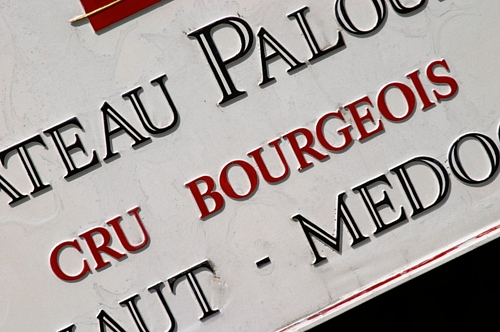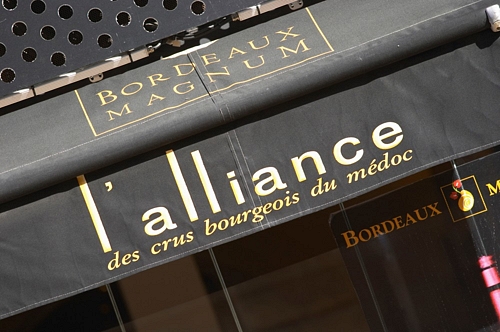In the olden times there was something called the Cru Bourgeois classification in Médoc (Bordeaux). But then, in 2003, they decided to review and modernise the classification. But unfortunately they hit on some road bumps. Some, who were left out of the classification were unhappy and thought that the procedure had not been fair. Eventually, the courts seem to have agreed and the new Cru Bourgeois classification was annulled. Rest in peace Cru Bourgeois. But now Cru Bourgeois has come to life again. But this time it is not a classification – classification is a very official term in French wine regions – but a “selection”. There are many difference compared to the old classification system.
The biggest change is no doubt that the label does not apply to a chateau, but for a single vintage from a specific chateau and will be awarded, as appropriate, each year. It is only producers in the eight Médoc appellations that will be eligible for the Cru Bourgeois label.
The awarding process is in three steps:
1) The property and the vinification facilities will be inspected at regular intervals (spanning several years).
2) Each vintage will be assessed by a tasting committee that will evaluate the quality and style of each vintage.
3) The wine producers can then for each vintage (two years after the harvest) apply to receive the label Cru Bourgeois (CB).
Those who apply will be tasted blind and if certain set minimum requirements are attained they will be give CB – for that particular wine/vintage.

In other words: A chateaux can one year make a Cru Bourgeois wine and the next fail to attain CB status. It is indeed an unusual procedure for a wine region. It more resembles a traditional wine competition like the Concours Mondial de Bruxelles or then International Wine Challenge than a classification. They award medals for a particular wine of a specific vintage. If we understand it right the chateau can only use CB on the label for a particular vintage.
How will it work? Will it work?
Will this be useful for the consumers? Very doubtful. On the other hand there are several questions: How will a wine consumer know if a wine (not a chateau) is CB or not? Will the producers be allowed to use “Cru Bourgeois” in their marketing communications, in spite of that they may not achieve CB every year? In practice it would mean that the chateaux can not write in e.g. their brochures that they are “Cru Bourgeois” since it varies from year to year… Or will the standards be set so low that everyone (who pays the fee to the Cru Bourgeois organisation) will be virtually guaranteed to pass?
Let’s say that the Chateau Xyz during a few years fail to get the CB label (perhaps because they make a wine in a style that is not liked by the tasting panel) will they then simply stop paying the fees to the CB organisation? Quite likely. Or, as a consequence, will the tasting committee have a tendency to be ‘co-operative’ since if they are not they will loose members?…
There are many questions around the new Cru Bourgeois label (not classification!) and we will probably not have the answers until it has existed for quite a few years. But the initial impression is that it will hardly make it easier for the consumer. And that one is rather trying to profit (with or without reason) from a classification that was created in 1932 and that has been annulled by the courts.
Read more on www.crus-bourgeois.com

And the winners in 2008 are…
The very first promotion of Cru Bourgeois labels have just been awarded – for the 2008 vintage. 290 chateaux were candidates but only 243 chateaux (84%) were passed the tests and the tasting. The whole list can be found on www.crus-bourgeois.com (but it is difficult to find and quite impossible to read – the site has a very slick design but is hopeless to navigate and information is difficult to find).
247 chateaux were in the 2003 Cru Bourgeois classification. Of those only 166 have the new CB stamp. The 243 chateaux who have been given the right to use the Cru Bourgeois denomination for the vintage 2008 (that label didn’t flow easily, did it?) represent all in all 44% of the 7200 hectares in the Médoc. In other words, CB is just under half of all the Medoc.
According to their site they had 270 members in the “Alliance” (that’s what the organisation is called: l’Alliance Cru Bourgeois) in 2009. How that fits with the 290 candidates for the CB label we do not know. Have twenty already left the Alliance?
Chateau la Tour de By renounces the Cru Bourgeois label
The first reaction among the producers to the new Cru Bourgeois label has come quickly. According to a press release from Chateau la Tour de By (www.la-tour-de-by.com) they have been give the Cru Bourgeois stamp for their 2008 vintage (and they were classified as Cru Bourgeois Supérieur in 2002) but they have decided to renounce from using it and have chosen to (at least temporarily) leave l’Alliance.
Frédéric Le Clerc, who runs the chateau since 2005, says that the Cru Bourgeois label “no longer corresponds to a real quality”. In his view, the new system pushes the wine producers to produce wines that do not reflect a traditional respect for terroir. Instead it benefits producers of exceptionally concentrated and oaked wines that are not typical for the Médoc region. He sees it as something that will push the wine towards a uniform international style. Chateau la Tour de By is indeed a property with a good reputation and that they renounce the new system is interesting. What will the reaction be from the other producers? Already earlier this year some other producers pulled out (www.decanter.com)
What is your view on all this? Good or bad? If you’re a wine consumer or a wine producer, we’re interested in your view!











2 Responses
Great article. This is unbelievable…a bureaucratic nightmare! I wonder if the economics are such that producers will subject themselves to such an ongoing review just to receive CB status.
It is indeed strange. It will be interesting to follow this in the years to come and see how long it survives. Watch out for part 2 and part 3 of the article. Coming soon.